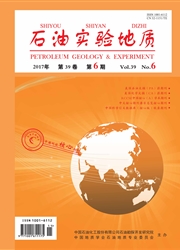

 中文摘要:
中文摘要:
须二段是四川盆地陆相天然气勘探的重要层系之一。天然气地球化学特征研究表明,新场地区须二段天然气干燥系数普遍高于0.95,为典型干气;δ13C1和δ13C2值分别为-34.5‰~-30.3‰和-29.1‰~-23.4‰,δD1值介于-168‰~-157‰之间,烷烃气碳、氢同位素系列主体表现出典型正序特征,部分样品发生了乙、丙烷碳同位素的部分倒转。新场须二段天然气为混合成因,重烃气表现出以原油裂解气为主并混有部分煤型气的特征,而甲烷则主要表现出煤型气的特点。气源对比研究表明,新场须二段天然气主要来自马鞍塘组—小塘子组烃源岩,须二段自身烃源岩也有一定的贡献。
 英文摘要:
英文摘要:
The second member of the Upper Triassic Xujiahe Formation is an important exploration target for terrestrial natural gases in the Sichuan Basin. The geochemical characteristics of natural gases indicated that the gases reservoired in the second member of the Xujiahe Formation in the study area have high dryness coefficients generally over 0.95. The δ13C1,δ13C2and δD1values are in the ranges of- 34. 5‰ ~- 30. 3‰,- 29. 1‰ ~-23.4‰ and- 168‰ ~- 157‰,respectively. The alkane gases mainly display positive stable carbon and hydrogen isotope values with several samples being partially reversed between ethane and propane carbon isotopes. These gases are of mixed origin,and the heavy hydrocarbon gases were mainly derived from the secondary cracking of oil augmented with coal-type gas,whereas methane was mainly a coal-type gas. Gas-source correlations indicated that the natural gases reservoired in the second member of the Xujiahe Formation were derived mainly from the source rocks in the Ma'antang and Xiaotangzi formations and augmented by those in the second member of the Xujiahe Formation itself.
 同期刊论文项目
同期刊论文项目
 同项目期刊论文
同项目期刊论文
 期刊信息
期刊信息
